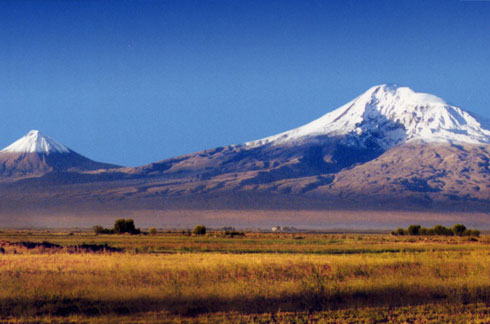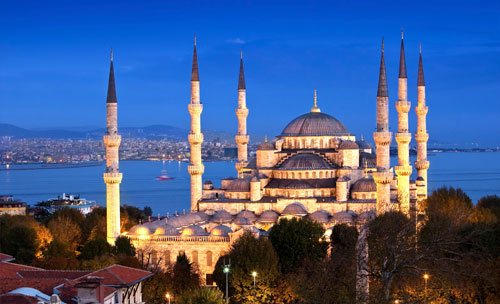Turkey
Country statistics

Land area: 297,591 sq miles (770,761 sq km)
Total area: 301,382 sq miles (780,580 sq km)
Population (July 2011 est.): 78,785,548 (growth rate: 1.235%); birth rate: 17.93/1000; infant mortality rate: 23.94/1000; life expectancy: 72.5
Capital City: Ankara
Monetary unit: Turkish lira (YTL)
Languages: Turkish (official), Kurdish, Dimli, Azeri, Kabardian
Ethnicity/race: Turkish 70-75%, Kurdish 18% (2008 est.)
Religions: Islam (mostly Sunni) 99.8%, other 0.2% (mostly Christians and Jews)
Country introduction

Turkey is at the north-east end of the Mediterranean Sea, in south-east Europe and south-west Asia. To the north is the Black Sea and to the west is the Aegean Sea. Its neighbors are Greece and Bulgaria to the west, Russia, Ukraine, and Romania to the north and north-west (through the Black Sea), Georgia, Armenia, Azerbaijan, and Iran to the east, and Syria and Iraq to the south. The Dardanelles, the Sea of Marmara, and the Bosporus divide the country.
Turkey's terrain is structurally complex and divides into five regions: the Black Sea region in the north; the Sea of Marmara region in the northwest; the Aegean Sea region in the far west; the Mediterranean Sea region in the south; and the Anatolian Plateau region in the country's center. All of the regions share a generally mountainous terrain, and many large lakes and rivers appear throughout the country.
Turkey is located on the Eurasian Tectonic Plate; however, the southern borders of the country rest atop the boundaries with the Arabian Tectonic Plate and the African Tectonic Plate. There is also a major fault line beneath the northern part of Asia Minor. As a result of its geological location, the country is subject to a very high level of seismic activity. The tremors cause massive damage to buildings and numerous deaths and injuries, especially if they occur at night during the winter months. The most earthquake-prone region centers on an arc that stretches from the general vicinity of the Sea of Marmara to the area north of Lake Van (Van Gölü), on the border with Georgia and Armenia.
The country has 8,333 km (5,177 miles) of coastline. There are narrow coastal lowlands along the Black Sea and Mediterranean coasts. The Aegean coastline is extremely irregular, with dramatic mountain faces rising perpendicularly from the sea and many islands just off shore (most of which belong to Greece). The Gallipoli Peninsula extends southwest from Thrace to form the northern side of the Dardanelles.
The country is mountainous. Pontic Mountains follow the Black Sea and Taurus Mountains follow the Mediterranean in the south. Between them there is the Central Anatolian highland. Turkey's highest mountain, Mount Ararat to the east has two peaks, with Great Ararat reaching 16,945 feet ( 5,165 meters). The mountain is considered sacred by many people and is believed to be where Noah beached his ark after the great flood.
The most well known rivers, Euphrates and Tigris, start from Central Anatolia and run to the Gulf of Persia. The longest river Kizilirmak (1,355 km / 841 miles) starts from Central Anatolia and runs to the Black Sea. The country has about 200 lakes, which cover 9,200 sq km (5,716 sq miles). The biggest lakes, Van Gölü (Van Lake) and Tuz Gölü (Salt Lake) have salty water.
The culture

Turkey has a rich and vibrant culture as a result of thousands of years of history. Following the fall of the Ottoman Empire in 1923, Turkey became a constitutional republic under the leadership of Mustafa Kemal Atatürk. Much of what is now modern day Turkey is just a fraction of the old empire which once spanned the continents of Europe, Asia and Africa and hosted many different ethnicities and customs.
Though 99% of the Turkish population is Islamic, the constitution has proclaimed Turkey as a secular state. The people are given complete freedom to choose their religious beliefs. However, Islam exerts a great influence over the culture and life of the people in Turkey. A moderate sort of Sunni Islam remains the unofficial religion of the state. The state appoints Imams to oversee the activities of mosques and Koran schools. Among certain obligations for Muslims are to pray five times a day, at dawn, noon, afternoon, sunset, and evening. Friday is the Muslim holy day although this is not practised in Turkey. However, most males will attend the congregational afternoon prayer. During the holy month of Ramadan all Muslims must fast from dawn to dusk. Fasting includes no eating, drinking, cigarette smoking, or gum chewing.
Turkish folk music and Turkish films reflect culture of Turkey Folk music was (and still remains) very energetic. Turkish music, which can be often heard on the radio, is traditional folk music but features a contemporary urban inclination. The main representatives of folk music are Turkish troubadours. The thousand year long tradition of Turkish troubadours was practically destroyed after the invention of television and video cassette players, but the songs of the great troubadours are still popular and are oftentimes re-recorded and broadcasted over the radio or on TV. Cinema in Turkey has a long history as it developed starting in the early '20s of the 20th Century and quickly became widespread after World War II Turkish films started to treat social and political problems in the 60s and 70s. Turkish films can be described as honest, realistic, and having a dry humor.
A typical breakfast in Turkey would consist of tea, bread, butter, white cheese, eggs, olives, honey and marmalade. White bean is the national food of the land eaten by every Turk. Raki or an aniseed-flavored grape brandy is the national drink. Some of the popular cuisines of Turkish tradition are noteworthy. Meze is a tray of small dishes consisting stuffed vine leaves, shish kebab grilled on a skewer, salads and a range of other items. Meat is normally grilled. Vegetables are prepared in olive oil. Rice palav is very common. The thick brew called Kahve is the Turkish coffee served during every meal. Turkish desserts include kadayif and muhallebi (milk pudding) and baklava (a dessert from pastry). Turkish bread is prepared from corn, wheat or barley. Some of the most important varieties of bread are Pide, tandir ekmegi, and simit. Regional variation in cuisines is very common in Turkey.
Attractions & landmarks

Unlike most countries the main attraction is not its capital, Ankara, but rather the ancient city of Istanbul. The city sits on the Europe-Asia border with the Bosphorous Bridge connecting the European and Asian parts of the city. Istanbul has been regarded as a hub of civilisation in the Middle East for much of its some 3,000 years of existence and as such has an impressive historical and cultural presence.
The Grand Bazaar is a must-see attraction; a labyrinth of tiny streets boasting a plethora of shops and street traders where visitors will find some truly unique souvenirs. It is one of the largest and oldest covered markets in the world, with 61 covered streets and over 3,000 shops which attract between 250,000 to 400,000 people daily. Visitors can also visit the famed Hagia Sophia, once the greatest church in Christendom and the exquisite Blue Mosque amongst many other architectural triumphs. The Blue Mosque in particular is a graceful and beautiful structure built to reflect the splendour of Islam. It was built between 1609 and 1616 and like many other mosques contains the tomb of the founder. Inside the mosque, the high ceiling is lined with 20,000 blue tiles with different patterns.
Ankara, the capital while not as impressive as Istanbul is still a worthwhile stop. The main draw is the Hisar, which is a hilltop Citadel from the Byzantine era which overlooks the city. Ankara was an important city during the Roman rule so there are a number of small Roman ruin dotted around the capital.
Many travellers also like to visit Ephesus, formerly Ionia, which has been inhabited by both the Greek and Roman Empires. Ephsus holds a significant number of well preserved ruins. Of primary importance is the Temple of Diana, one of the seven wonders of the Greek world and still an incredibly impressive sight. A day can easily be spent exploring all of the various ruins that the city has to offer.
Pamukkale, meaning "cotton castle" in Turkish, is an unreal landscape in western Turkey, famous for its white terraces. The terraces are made of travertine, a sedimentary rock deposited by water with a very high mineral content from the hot springs. People have bathed in its pools for thousands of years. The ancient Greek city of Hierapolis was built on top of the hot springs by the kings of Pergamon. The ruins of the baths, temples and other Greek monuments can be seen at the site.
There are many coastal beaches to visit in Turkey. At 14 km (9 miles), Patara is one of the longest stretches of sandy beach found anywhere in the Mediterranean. The beach is backed only by ancient Lycian and Roman ruins and swooping dunes with no buildings visible except of a small café. Patara Beach is also the breeding ground of the endangered Loggerhead turtle. The nearby village of Patara was the birthplace of St Nicholas, the 4th century Byzantine bishop who later passed into legend as Santa Claus.
Mount Nemrut is one of the most spectacular sites in Turkey especially at sunset. At 2,134 m (7,001 ft) high, the mountain is an extension of the Taurus mountain range in southeastern Turkey. The summit of Mount Nemrut provides a great view of the surrounding mountains. The main attraction is to watch the sunrise from the eastern terrace which give the bodyless heads a beautiful orange hue and adds to the sense of mystery of the place.
There are plenty of things to do off the beaten track. For those interested in history there is the city of Troy which is central as the city of Ilium in Homer's Illiad. Excavations here have unearthed evidence of nine ancient cities on and around this site dating as far back as 3,000 BC.